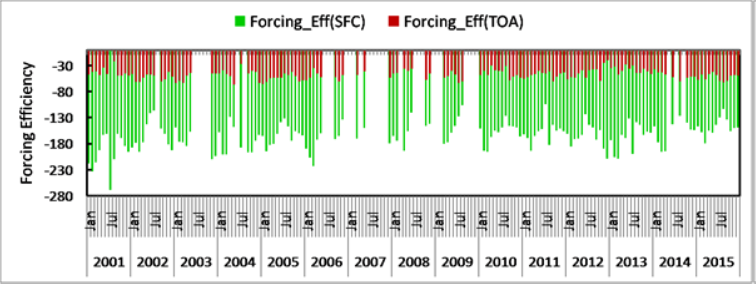


Indian Journal of Science and Technology
Year: 2020, Volume: 13, Issue: 27, Pages: 2774-2785
Original Article
Raj Kumar1,2, Gulshan Kumar3*, Mukesh Kumar4, Raj Paul Guleria5
1Department of Physics, Career Point University Kota, Kota, 324005, Rajasthan, India
2Department of Physics, Govt. College Ghumarwin, District Bilaspur, 174021, Himachal Pradesh, India
3Department of Physics, Govt. College Sarkaghat, District Mandi, 175024, Himachal Pradesh,
India. Tel.: +919418195031
4Department of Physics, Lovely Professional University, Phagwara, 144411, Punjab, India
5Department of Higher Education, Govt. Of Himachal Pradesh, Himachal Pradesh, 171001, India
*Corresponding author
Tel.: +919418195031
Email: [email protected]
Received Date:19 April 2020, Accepted Date:24 July 2020, Published Date:31 July 2020
Objective: To find the influence of aerosols on the sun rays arriving at the surface and to measure aerosol radiative forcing over Kanpur, Indo-gangetic basin. The study was performed during period 2001-2015. Methodology: The present work is credited to the availability of data through the network relying on the ground based optical observations obtained with the help of ground based instrument called Cimel sun photometer using AERONET (Aerosol Robotic Network) radiative transfer model with particular focus on Indo-Gangetic plain over Kanpur. The aerosol radiative forcing at the surface, atmosphere and top of atmosphere has been computed with the help of radiative transfer approach depending on AERONET aerosol retrievals. Findings: Our study investigated the seasonal and spectral variations of ARF along with aerosol radiative forcing with special reference to Kanpur region (IGP) by using AERONET data. The monthly average (±σ) ARF during the entire observational period (2001-2015), at three levels i.e., surface (ARFSFC), atmosphere (ARFATM) and the atmospheric top (ARFTOA) are recorded as – 89.6±18.6 Wm–2, +64.4±16.5 Wm–2 and –25.2±6.8 Wm–2 respectively. From the ARF measurements, it is found that there is a large reduction in surface arriving solar rays due to presence of absorbing and scattering types of aerosols. Novelty: Since this study provides an overview of the present state of prevailing aerosols and their climatic effects. So, findings may be used to create an aerosol climate map for the region under study.
Keywords: Aerosol robotic network; aerosol radiative forcing; global atmospheric model; sun photometer
© 2020 Kumar, Kumar, Kumar, Guleria. This is an open-access article distributed under the terms of the Creative Commons Attribution License, which permits unrestricted use, distribution, and reproduction in any medium, provided the original author and source are credited. Published By Indian Society for Education and Environment (iSee).
Subscribe now for latest articles and news.